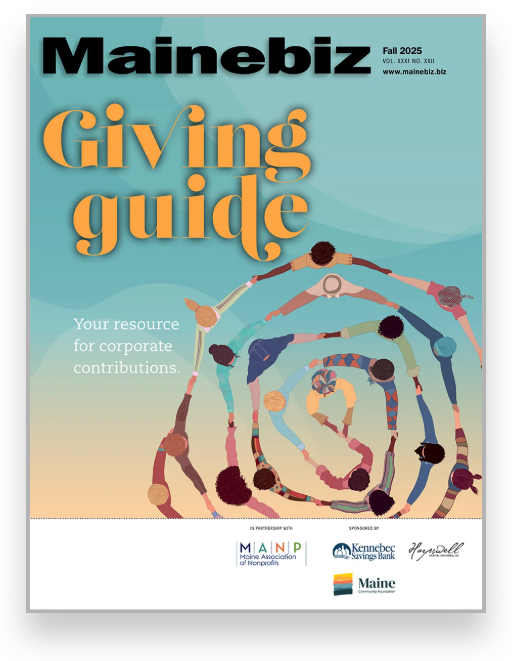Processing Your Payment
Please do not leave this page until complete. This can take a few moments.
- News
-
Editions
View Digital Editions
Biweekly Issues
- October 20, 2025
- October 6, 2025
- September 22, 2025
- September 8, 2025
- August 25, 2025
- August 11, 2025
- + More
Special Editions
- Lists
- Viewpoints
- Our Events
- Calendar
- Biz Marketplace
Energy opportunities | Ideas for a new Maine economy based on green innovation surface at GrowSmart summit
“Charting the Course” is written by GrowSmart Maine, a Yarmouth nonprofit that promotes and encourages new ways of thinking about Maine’s future. This issue’s column was written by Christian McNeil, GrowSmart’s communications director.
Last month, GrowSmart Maine’s fifth annual summit attracted over 500 highly engaged Mainers to the Augusta Civic Center. In spite of an extremely discouraging week of economic crises and pessimism, we were incredibly energized by the day’s optimism and sense of possibility.
To be sure, we face serious challenges: The rising cost of government is compromising our ability to invest in our infrastructure and economy, while rising energy prices and credit costs squeeze Maine’s households and businesses. But almost everyone at the summit also understood the remarkable opportunities these crises offer Maine.
Mainers are famously resistant to change, and our state has dithered for too long on important questions of how to grow our economy, protect our environment and streamline government.
But these times absolutely demand that we change. Now is the time for Maine people to come together and seize a better future for our state.
Drafting the new economy
Perhaps it was the backdrop of dismal economic news, but the day’s workshops and keynotes focusing on the opportunities of a new economy seemed to generate the strongest enthusiasm at the summit.
Joel Rogers, co-founder of the California-based clean energy coalition Apollo Alliance and founding director of the Center on Wisconsin Strategy, was the hit of the day with his engaging lunchtime discussion of what the emerging “green innovation” sector has to offer to Maine’s workers, businesses and energy consumers.
Rogers began his keynote with an overview of the old economy. He noted that the past 40 years have tracked the disappearance of career advancement within firms and an increase in wealth disparity. Middle class wages haven’t kept pace with increases in productivity. We’ve saturated our atmosphere with greenhouse pollutants. What growth we had over the last decade now seems to have been a flimsy façade propped up by artificially cheap energy and debt.
The collapse of this economy, in other words, may not be such a great loss.
So what comes next? Rogers is a believer in what he calls “high road” economic development: economic growth that adds value, reduces waste and empowers a democratic public with shared prosperity. Increasing worker productivity will generate higher wages. Reducing wasteful consumption (Rogers focused on transportation, which consumed over a fifth of the average household’s income in 2004 and consumes substantially more today) will increase disposable income.
Rogers said Maine could capitalize on its human and natural resources to leap into the high road economy by building a new renewable-energy cluster and by mobilizing a huge new workforce to make Maine buildings more energy efficient.
Turning to energy efficiency
Still, for all the potential for new energy sources in Maine, Rogers said the potential for energy efficiency is even bigger. Efficiency measures, while less impressive than wind farms, deliver a higher return for every dollar invested. Efficiency efforts (including utilities’ efficiency projects, recycling industries and the insulation industry) already employ about 20 times as many people as the renewable energy industry nationwide.
Maine’s old building stock creates even more opportunity for efficiency, since relatively modest expenditures here can deliver huge results. The U.S. Environmental Protection Agency and the Pennsylvania-based investment firm Vanguard Group have estimated that energy efficiency investments have an average annual return of over 20% and are as low-risk as Treasury bills.
Unfortunately, existing markets create barriers to these low-risk, high-return investments. For now, transaction costs are too high, and there’s a difference in incentives between builders who want to minimize initial construction costs and tenants who want to minimize long-term costs that include paying for energy.
Rogers pointed to a pilot program in Wisconsin that allows ratepayers to pay back the costs of energy efficiency retrofits with a small surcharge on their utility bills. The surcharge is large enough to pay back investors with an attractive interest rate, but is less than the homeowner’s total energy savings. By creating a well structured market of this sort, Maine could introduce a lucrative investment opportunity, generate thousands of new efficiency-service jobs and businesses and substantially reduce energy expenditures.
The gung-ho optimism at the summit was a natural outcome of ideas like these. To anyone who takes a big-picture view of Maine’s environment, our economy and our government, it is evident our state is on the cusp of tremendous changes, and tremendous opportunities.
Christian McNeil can be reached at cmcneil@growsmartmaine.org.
Mainebiz web partners

The Giving Guide
The Giving Guide helps nonprofits have the opportunity to showcase and differentiate their organizations so that businesses better understand how they can contribute to a nonprofit’s mission and work.
Learn More
Work for ME
Work for ME is a workforce development tool to help Maine’s employers target Maine’s emerging workforce. Work for ME highlights each industry, its impact on Maine’s economy, the jobs available to entry-level workers, the training and education needed to get a career started.
Learn More
Groundbreaking Maine
Whether you’re a developer, financer, architect, or industry enthusiast, Groundbreaking Maine is crafted to be your go-to source for valuable insights in Maine’s real estate and construction community.
Learn more-
The Giving Guide
The Giving Guide helps nonprofits have the opportunity to showcase and differentiate their organizations so that businesses better understand how they can contribute to a nonprofit’s mission and work.
-
Work for ME
Work for ME is a workforce development tool to help Maine’s employers target Maine’s emerging workforce. Work for ME highlights each industry, its impact on Maine’s economy, the jobs available to entry-level workers, the training and education needed to get a career started.
-
Groundbreaking Maine
Whether you’re a developer, financer, architect, or industry enthusiast, Groundbreaking Maine is crafted to be your go-to source for valuable insights in Maine’s real estate and construction community.
ABOUT
NEW ENGLAND BUSINESS MEDIA SITES
No articles left
Get access now
In order to use this feature, we need some information from you. You can also login or register for a free account.
By clicking submit you are agreeing to our cookie usage and Privacy Policy
Already have an account? Login
Already have an account? Login
Want to create an account? Register
Get access now
In order to use this feature, we need some information from you. You can also login or register for a free account.
By clicking submit you are agreeing to our cookie usage and Privacy Policy
Already have an account? Login
Already have an account? Login
Want to create an account? Register







Comments